Bumps In the Road
I engorged on a hostel breakfast while talking to a tall German who'd traveled extensively in South America. I stopped by the private courier service on my way out of town, hoping I could still send those three kg of supplies, but they don't do international shipping, only domestic. I tentatively headed out of town, now on my fatter tires, knowing I wouldn't see a full day of pavement for a while.
There was a good 25 km of pavement to one last small town in Argentina. I decided to try the post office there. Maybe customs is open there Tuesday and Thursday mornings? Maybe it alternates with the schedule in Esquel?
I waited behind one person, then stepped up to the counter. There were two men working. They were engaged in conversation and failed to acknowledge me. I waited for a break in their conversation.
"Excuse me, can I send-"
"No."
I waited a second. Did that really happen? Maybe if I tried again.
"Can I send these things to the United States-"
"No."
I paused again. That was incredible. I'd been interrupted twice, both times before they even fully understood what they were refusing. After two tries, I still hadn't managed to get through one sentence. I took a breath.
"Can I finish?" They both made eye contact and didn't say anything. OK, maybe now. "Thank you. Is it possible to send these things to the United States? I do not have a box, but I can pay. It is not necessary they arrive quickly."
They explained that customs doesn't serve this post office at all, and that I'd have to go back to Esquel. Since customs wouldn't be open there until tomorrow, and it was 25 km behind me, that meant I'm not sending the stuff home.
Only a couple km out of town, the gravel started. Lots and lots of loose rocks. I slowed considerably and had trouble maintaining traction in places. And this was in a flat area. When I get on the Carretera Austral and have to get traction on a hill...!
I'd read that this road leading to the Carretera Austral was worse than the Carretera Austral itself. That helped me get through, knowing that I was getting the worst part over with now. It also helped that the road followed a river downstream for most of the day. It was a weird thought; I'd figured that I'd have to climb over a pass to get into Chile, and instead, I was descending.
One the hills kicked in, the road got a little better. There were still a lot of rocks, an obnoxious amount, but now they were firmly embedded in the road. Just as bumpy, but not as slippery. Like always, a strong headwind picked up...
In early afternoon, I made it to the Chilean border. Both the Argentinian and Chilean offices, despite being small, remote crossing points, were staffed with intelligent people who acted professionally. I haven't had such a painless border crossing in a long time! I think the only ones that compare are Ecuador-Peru, USA-Canada (and vice versa), and perhaps surprisingly, USA-Mexico.
For only the second time, the first being Mexico, someone asked what was in my panniers, and even asked me to open each one and show them the contents. Chile is worried about diseased produce, much like California, and doesn’t allow almost any food or organic material in, not even things like bread, honey, or even wood! I had two mandarins and an apple with me. It was time for a snack anyway, so I went ahead and ate them all.
Since I put it on, my Texas flag is mistaken for a Chilean one about five times a day. I figured when I got to Chile, that would stop happening, because they'd know their own flag well enough to notice the difference. But as someone was checking my panniers, they exclaimed, "I like your Chilean flag!"
I had to laugh. "It's not Chilean! It's Tejano!"
She gave me a look. "I'm from Texas. This is the flag of Texas, my state. It is similar to Chile, but not the same."
I'm not even kidding, she looked back and forth between my flag and the one outside the immigration office, three or four times, and then said, "Yeah, huh!" So I guess this confusion is going to continue.
The next ten km were paved, to Futaluefu, a small town in Chile. All downhill, sometimes steeply. But in a wide-open area with the strong wind in full force. I dropped into lower gears and put my head down - to make it down a hill on pavement!
Futaluefu, for its size, had a surprising amount of services. Two banks, a small grocery store, a bakery, a couple restaurants, several lodgings, and an office for exchanging currency, even dealing in America dollars! Since I'd be going back to Argentina, I didn't feel the need to change my pesos, and only withdrew some Chilean cash from the bank.
It got hillier as I went, and colder, and cloudier. The gravel, upon its return, was no better. Rocks, and more rocks. When there was a gap in the rocks, washboard, sometimes very pronounced. I was still following the river downstream, but the terrain was in random mode. I guess the downs must have been a little bigger than the ups, though.
Only an hour before I stopped, it started to drizzle. Just then, I met three Brazilians on mountain bikes, headed the other way. They were doing the Carretera Austral, north-to-south like I was intending, but had started it at the very top, in Puerto Montt. They were now making a side trip to Futaluefu. I'm not sure why; the town was good for a quick stop, but nothing that would be worth a trip.
As I pushed on, despite the hills, wind, rain, cold, and crappy road, I managed to keep my spirits high! Well, maybe not high, but I was surprisingly not upset at all. I was able to remind myself that I knew all along that the pavement would be bad, this area was known for rain, and there's always headwind in Patagonia. I knew this was coming and signed up for it anyway. This wasn't any worse than I expected. Being mentally prepared helps a lot. When it's bad and it's supposed to be bad, you're OK. When it's bad and it's supposed to be good, those are your worst moments.
I managed to make it to a small village, maybe about 8 buildings strong. I looked around, thinking maybe I'd see something, any place that looked like a place I'd be allowed to set up my tent. Nothing that I could see, and no humans walking outside either. I'd made it almost out of town when I found an older lady walking. We were near a bridge, next to which there was a clearing by the river.
"Excuse me, do you know a safe place to use my tent?"
"Over there!" She pointed to the grassy river bank, with a tone like it was obvious.
"And there are no problems, no one is going to bother me?" It was out in the open, clearly visible from the road, not that there was much traffic.
"No, no!" She looked at me like such an idea was ridiculous.
One of the nice things about being out here!
The drizzle had stopped by the time I'd made it to this town, but the wind hadn't, and it was still cold. I would've liked to sit by the river and have dinner, but I got inside my tent instead. Still, I liked my pretty campsite, and the gentle sounds of the river flowing along were a pleasant companion to sleep.
I made it to the Carretera Austral in mid-morning, sort of impressed by the small town there. It had a sizeable plaza, even though the town was small enough that the plaza must have been a quarter of its total size. I found a bakery, bought some bread and cheese, and sat in the plaza for an early lunch.
I'd been told that half the distance between Santa Lucia and La Junta was paved. 34 km of pavement! Sounded great!
In reality, half the distance south of Santa Lucia was under construction, and half of that was paved. Still, I'll take what I can get. When there was pavement, I couldn't stop smiling.
One thing that surprised me was the human influence - this area hardly seemed remote. On both sides of the highway, there was an ongoing barbed-wire fence, and nearly all the land was clearly private property; you couldn't go more than 30 seconds or so without seeing another building, at least most of the time. It was a far cry from what I'd expected, having read that this is one of the wildest, most untouched bike routes in the world. I guess some people have never been to Alaska, or the Yukon, or some parts of British Columbia, or half of the American West. There are dozens of highways in Texas more empty than this, and it's the second-most populous state!
I met a couple in Quito that had told me the Carretera Austral was currently being paved. I took that as good news, but what they said next surprised me. They added that it was ruining the Carretera Austral, that people and shops and hotels and restaurants were moving in. As I'd thought it was almost devoid of people, I liked the idea of being able to resupply more often! But now I saw what they meant. Apparently, it used to be possible to stop virtually anywhere along the highway, walk a dozen meters into the woods, and set up your tent. That is not the case anymore.
Further, they'd told me that the areas under construction were the worst parts. At first, I disagreed: the areas where they were actively working were really no worse than the other areas nearby. But when I finally got far away from the construction zones, I saw what they were talking about.
A too-large amount of the Carretera Austral is covered in loose rocks, the size of strawberries. At times, sometimes for 5-10 km at a time, there's not even any space between; you can only ride on the rocks and try your best not to fishtail.
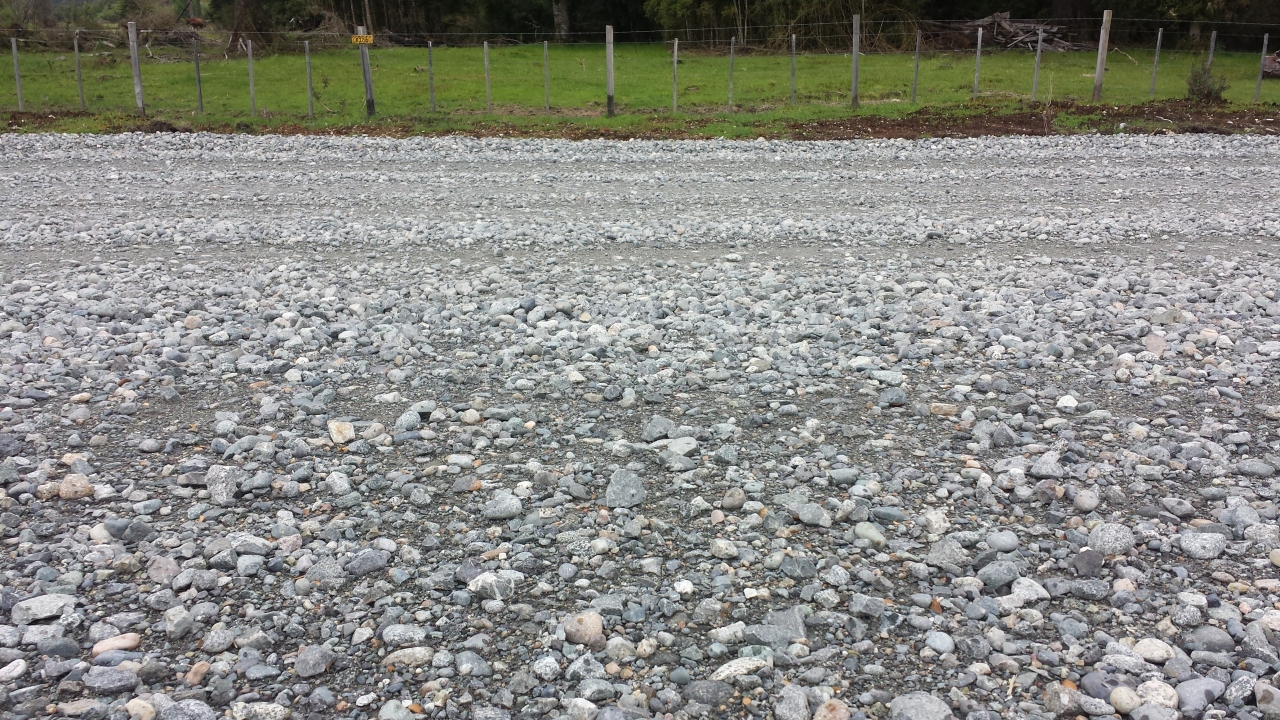
At one point, I asked a construction worker why the highway was covered in rocks. There were too many for it to be a natural occurrence, and the ground nearby didn't have nearly so many. He explained that the rocks were there for making cement. OK, but until the cement is made, isn't there a better place to store the rocks other than on the surface of the highway?
When far enough away from the construction, the road was as good as non-pavement gets. Smooth, firm hardpack, no gravel or rocks on top, no washboard. I've seen paved roads in worse shape! If the rest of the Carretera Austral is like this...?
I asked a local, one who'd biked almost all of the Carretera Austral, if the southern half was more like the good sections in the northern half.
"Oh yeah, there's no construction in the south, so it's like this."
That just might change things...
I arrived in La Junta at around 6:00 PM, not too tired. The sun doesn't go down until 9:00 PM or so. I could keep going if I wanted to. But I decided to stay in a cheap lodging, if only for two things: WiFi, and the chance to have some good fish for dinner.
The place had WiFi, but it wasn't until after I'd brought everything in and taken a shower that I found out it didn't work. I asked a few locals, and they said there was nowhere good for fish. Oh well...at least I got a hot shower.
I managed to make good enough time the next day that Coyhaique, the lone big city on the Carretera Austral, looked possible in two days instead of three! At midday, I made it into a small pueblo that had free open WiFi at the information center and a supermarket with a surprisingly good beer selection. I wrote to my WarmShowers host in Coyhaique, letting him know that I might arrive a day early, if that was OK. And I bought two beers, to enjoy later.
For the first time on the Carretera Austral, there was a long climb. Those are rare here. There are plenty of hills, but they're short, frequent, and steep, rather than long and tall. This one though, coming towards the end of a long day, had a way of taking it out of me. But at the top, I finally got a glimpse of the dramatic scenery the Carretera Austral is known for.
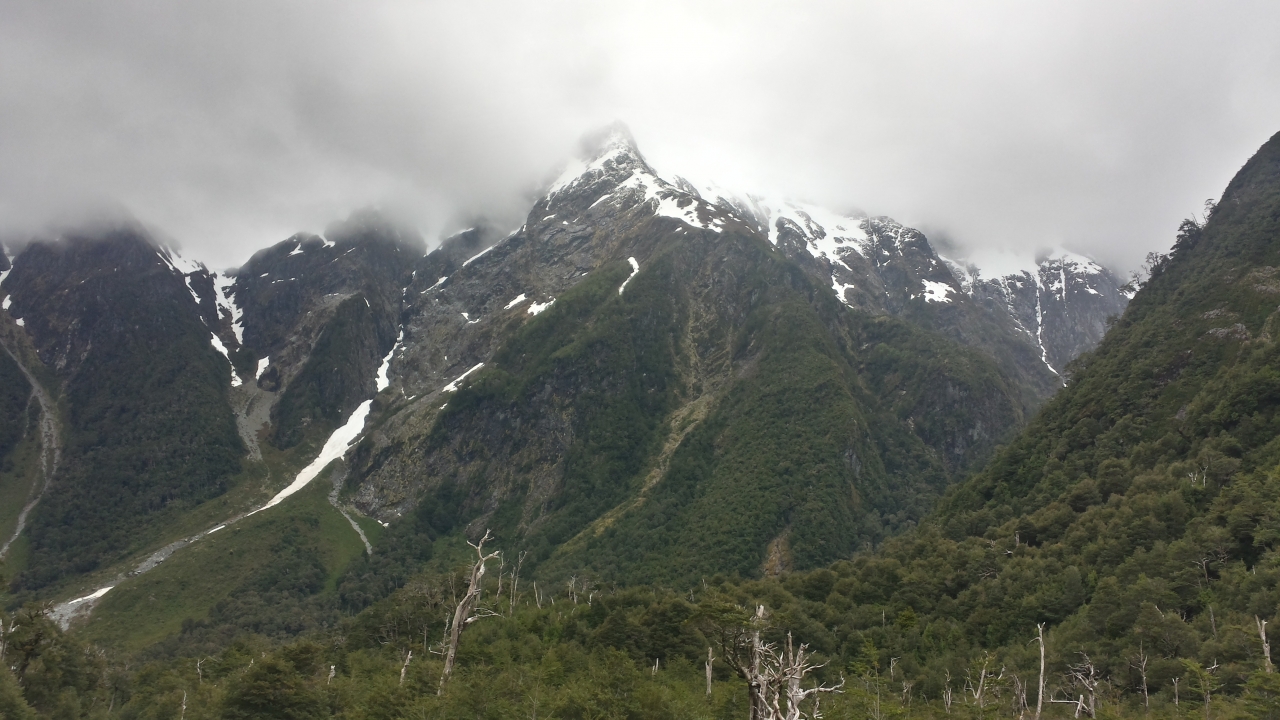
Only a little later, I met some motorcyclists stopped, taking it in the same as me. Motorcyclists and cyclists share a kinship. They may not be pedaling like I am, but we're both in the elements. We have to limit what we carry with us, and we have to deal with the rain, wind, heat, you name it. And when the road is bad or there are lots of hills, it's more than a matter of touching pedals differently, they have to make adjustments and deal with it much like I do, even if it's a little less work. Motorcyclists and I tend to make fast friends, and when I wave, they always wave back.
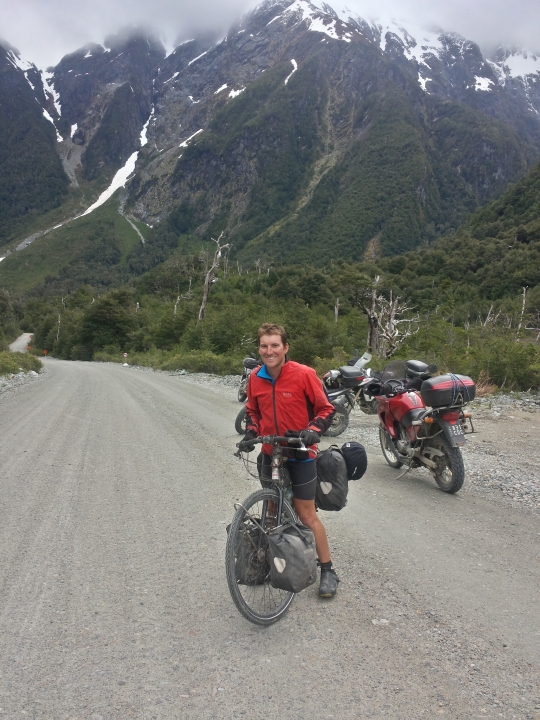
After a too-steep descent that had me nervously holding the brakes the whole time, the pavement reappeared - 85 km before I expected! OK, now Coyhaique is possible tomorrow. I hauled my behind down the highway, trying to take full advantage of the favorable surface, and to make tomorrow a more reasonable distance.
I had a certain distance in mind, but as it was getting dim, with a good 45 minutes of safe riding still possible, I noticed a near-perfect campsite: flat, a little sandy, but not too loose for the stakes. Right next to a beautiful river. Surrounded by trees, and in a depression, where it would be almost impossible to see from the road. In fact, I first saw another spot next to it, and only noticed the one in the trees when I walked over. Someone had even built a fire ring out of stones, so I was hardly the first person to camp here. I smiled, cracked open a beer, and sat watching the river flow by, taking it in before setting up my tent for the night.
Getting to Coyhaique in one day looked like it could be a challenge, and after the past few days, 150 km seems like an extreme distance. I reminded myself it was all paved, and it would pay off in the form of a good host.
The originally planned destination for the day was Manihuales, at a Casa de Ciclistas. Not only did I not have the address, but I hadn't gotten a response when I tried emailing the owner. Not uncommon for Latin America, of course. I wound up stopping in that town for a quick lunch, but saw no indication of the place. So clearly, I wouldn't have been able to stay there anyway.
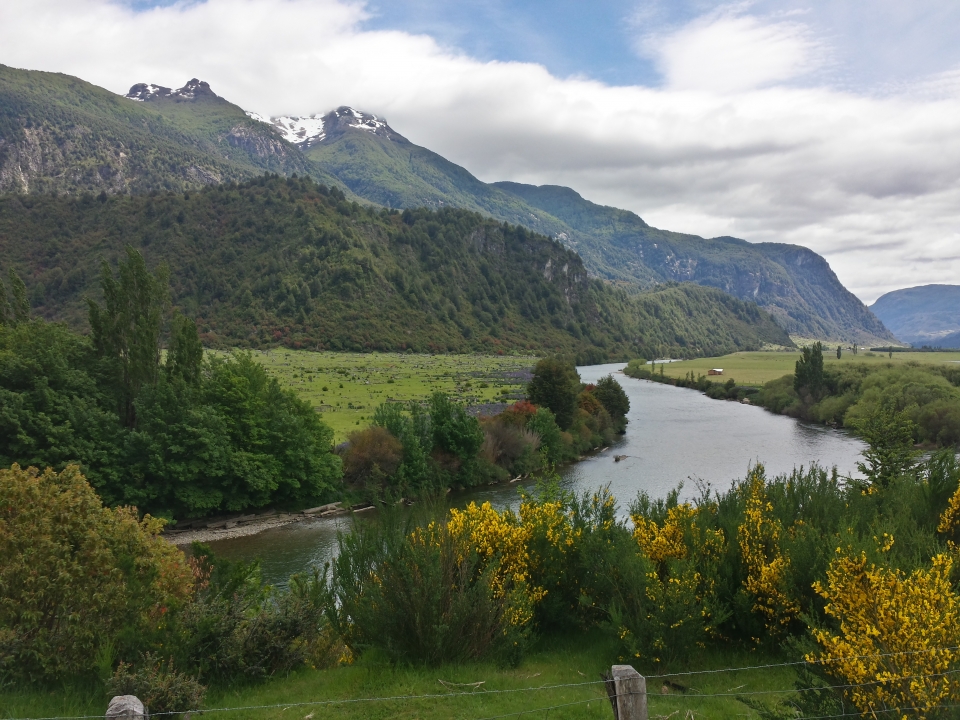
While I was in Manihuales, the afternoon wind did its usual thing and asserted itself. I'd have to go into it for 35 km, then turn around and ride with it for the last 35 km into town. But to even things out, the headwind section followed a river downstream, and the tailwind section did the opposite. Still, I knew it would be easier with the wind.
People in Latin America aren't good at estimating distance, and that trait is shared by its road signs. Sometimes you'll even see a sign declaring that a town is 43 km away, and 20 minutes later, that number has magically increased to 48 km. So Latin America has invisible teleportation portals? Or are they wormholes?
But today, I saw a road sign so magnificent, so accurate, so perfect, it could only come from here:
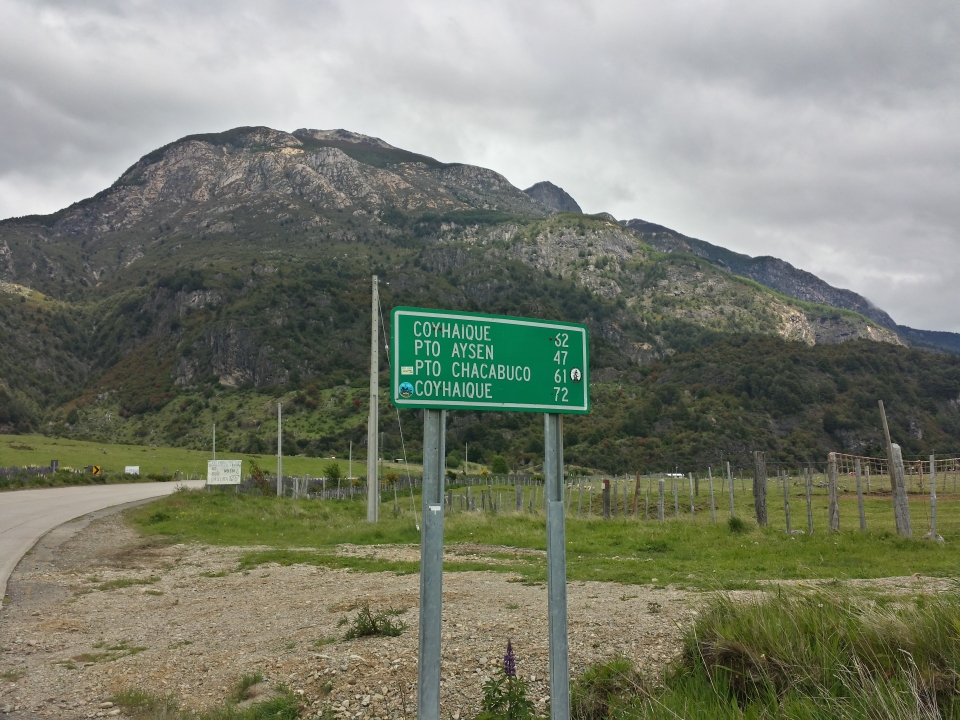
Reaching the corner to get the tailwind seemed to take forever, but once there, the day turned around in a big way. The air felt warmer, the riding effortless, and the distances shrank quickly. Also, I don't know the names of these purple flowers, but they give bluebonnets a run for their money.
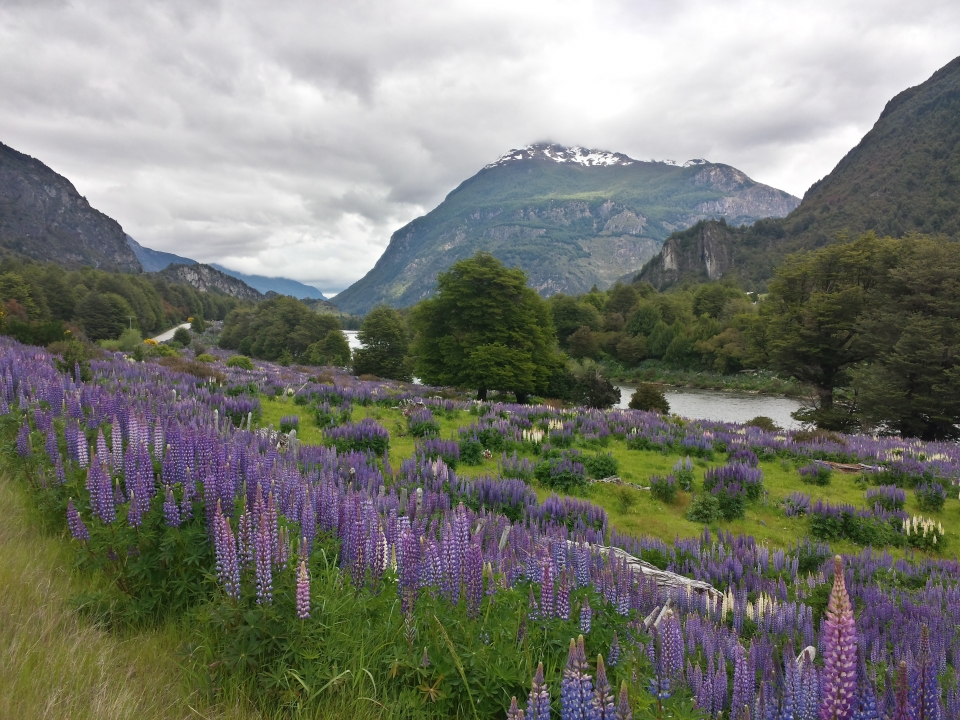
There was one final big hill to get to Coyhaique, including a tunnel! By now, the sun had come out, and it started feeling hot during the climb. For whatever reason, I belted out Robert Earl Keen, followed by Rod Stewart. I was in a good mood.
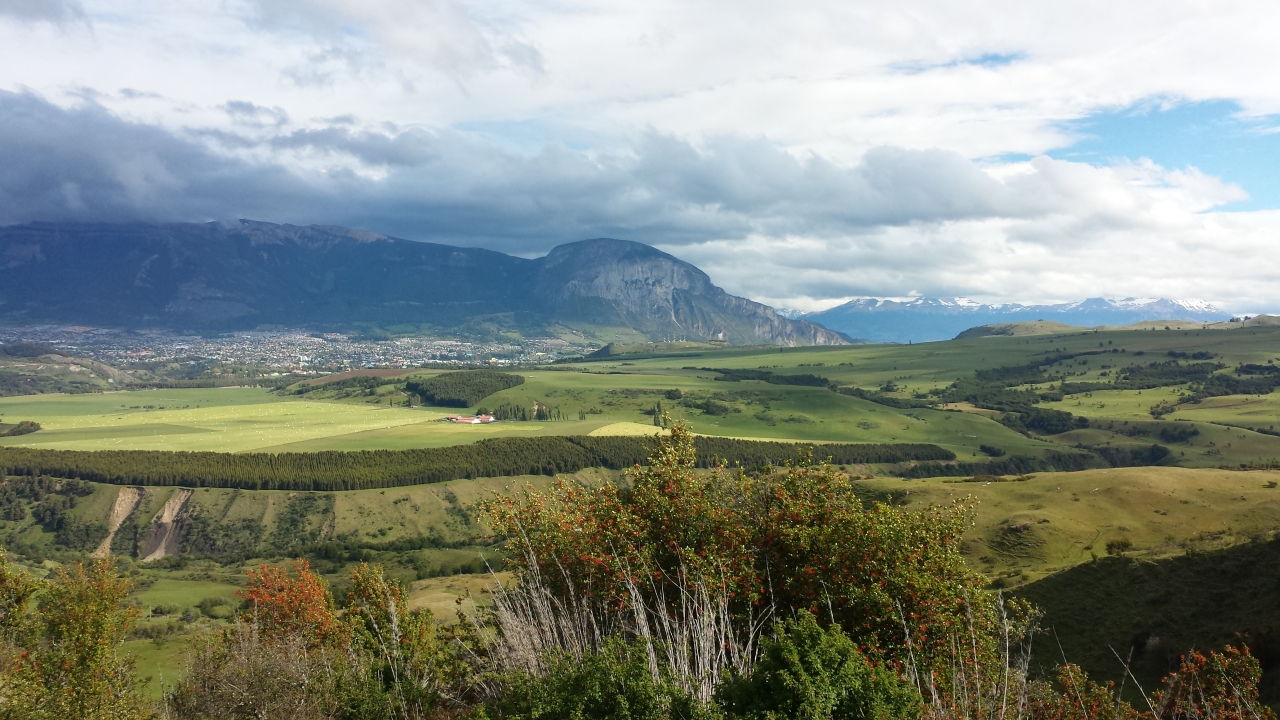
Just before a steep descent was an overlook from which one could see Coyhaique. There were three young men sitting there, drinking a beer.
"Mhnnghuh?" said one of them. Most Latin Americans talk too fast, but this was a new level. It sounded like he crammed an entire sentence into one syllable.
"What?"
"Nnhhguh?"
I paused and tried to concentrate. Was there a word I recognized somewhere in there?
"I'm sorry, I don't understand in total."
"Speak Spanish?" Another one said, in English.
"Yes, I speak Spanish," I replied, in Spanish, "but slowly. I need separate words. I don't understand 'mnhgnnuh.' That signifies nothing to me."
I got back on Valeria and headed down the hill. As I left, I could hear them laughing. I had no idea if it was at me, or maybe their possibly drunk friend, but I didn't care. Glad I made them laugh either way.
One last steep climb into town, then I found Patricio's place. He wasn't there, and I had no way to call. I'd shown up a day early, with a warning email, but hadn't had WiFi access recently, so I hadn't gotten a response yet. I was about to leave and try to find an internet cafe to check if Patricio had said yes or no, when he showed up, home from work, only about ten minutes after I arrived. Good timing!
Patricio, a horse vet that works for the police, led me inside and immediately began cooking pasta, but not before handing me a beer. Now this guy knows what's up! He encouraged me to take a hot shower while he finished cooking pasta.
Patricio went to visit his kids for dinner. In other words, the pasta wasn't for us to share, he cooked it just for me! I happily gobbled it up, and upon Patricio's return, he asked me if I wanted to go out for pizza and beer. Can't say no to that!
We went to a local brewpub that made its own craft beer, along with more pizza creations than you could shake a stick at. Patricio and I split one with different toppings, as I wanted to try something weird (salmon), and Patricio is a vegetarian. He's seen the meat industry up-close a few times, and doesn't believe in some of its practices.
"Are you vegan too?"
"No. In Chile? I would die."
Over one of the better dark amber beers I've ever had, Patricio revealed a little more about himself as the night went on. He is in his 40s and recently divorced, though seems to be taking it well. He does not practice any specific religion that I could tell, but knows an awful lot about Buddhism and Hinduism, and appears to share in a few of their beliefs. Shortly after his divorce, he got a tattoo reading "Embrace Shiva."
"There are not many gods in Hindu, but many manifestations of God," he explained. "Shiva is the destroyer. Is sounds negative, but in Hindu, it is not. Destruction is merely what is necessary before a change. I try to embrace change."
Patricio loves to cook, and his three kids' favorite thing to cook with him is lasagna. I had a chuckle at that. My dad and I still cook lasagna together the day after every Thanksgiving and Christmas.
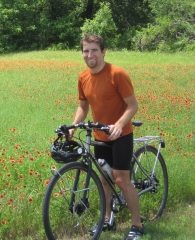


 June
June

